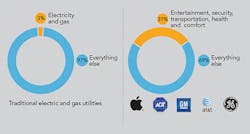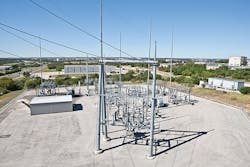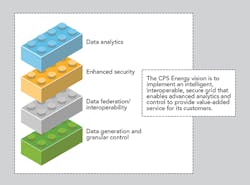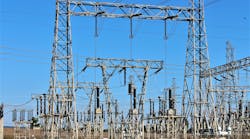Yogi Berra once quipped, “If you don’t know where you’re going, you might wind up someplace else.” Utilities are currently facing a journey like the one Yogi envisioned, a journey with a very uncertain destination. Yet, it is apparent the utility business models and operations must evolve as new and transformative technologies continue to find their way deeper into power grid operations. Mega trends are playing out concurrently, defining the path utilities are on today.
New forms of customer choice will be enabled, and utilities must evolve to remain relevant. CPS Energy and OMNETRIC Group have defined a multistep path to success that starts with an analytics strategy and roadmap definition for data integration that forms the foundation for the future.
Transformation at the Grid Edge
Distributed energy resources (DERs) are changing traditional utility operations at the grid edge. Customer needs are evolving as new market entrants using DERs provide load choreography, lifestyle management and energy-savings opportunities once thought unrealistic. With DERs multiplying, the utility must respond with more data and control over the grid edge. This transformation is adhering to Moore’s Law (the observation that, over the history of computing hardware, the number of transistors in a dense integrated circuit has doubled approximately every two years) as utilities install smart assets that enable new capabilities to manage DER impacts. These multifunction, lower-cost hardware assets with greater processing capabilities are appearing with increasing regularity.
As utilities install smarter devices, the need to move, secure and manage data efficiently becomes paramount. Metcalfe’s Law (the value that a telecommunications network is proportional to the square of the number of connected system users) demonstrates that as utility telecommunications and logic networks grow, they will be critical to creating grid-edge functionality. Interconnection and interoperability of electric, logical and telecommunications grids are a necessity to getting value out of the grid.
The generation and movement of large amounts of data are enabling big data analytics. Improving utility operations, reducing costs and creating new business models and products are now within easy reach. Data from nontraditional sources and outside of historic operating silos produce even greater nuggets of value and facilitate new capabilities.
Evolve to Remain Relevant
In light of these trends, new forms of customer choice will be enabled, and utilities must evolve to remain relevant. Unfortunately, utilities have long struggled with consistent customer engagement beyond the occasional power outage or monthly bill. In fact, according to the U.S. Bureau of Labor Statistics, the average American family of four spends only 3% of disposable income on electricity and natural gas while spending 31% on things that use electricity and gas. Thus, companies like Samsung, AT&T and Google are currently 10 times more relevant to the consumer than utilities.
However, the utility grid can bridge the customer relevance gap, becoming a value creator for customers who want better control over their energy experience. But customers loathe complexity (like difficult-to-understand rates) and do not care about engineering jargon when used to stymie getting what they want. Utilities cannot apply old methodologies, hoping to arrive at this new destination. Yet, paraphrasing R. Buckminster Fuller, how are utilities supposed to make this transition when they often feel like they are asked to do more and more with less and less until they should (theoretically) be able to do everything with nothing? Simply put: Listen to customers and build what they are asking for.
Grid of the Future
CPS Energy believes the path forward leads to a destination where a customer’s energy-related needs are served by the grid of the future. The transformation of the grid into a customer-enablement engine requires the utility to do everything from the customer perspective — a perspective that has dramatically shifted over the last few years away from most traditional paradigms.
Customers today want more DERs as well as new capabilities like micro-grids and smart thermostats. Thus, the electric grid should be designed to maximize DER penetration and easily integrate new components, regardless of whether they are on the customer or utility side of the meter. Similarly, since customers want more control over their energy usage and may use third parties to manage their energy experiences, the grid of the future needs to be able to provide for more granular control, enhanced security and valuable analytics to better plan and operate the grid.
Together, these attributes make up the building blocks of the grid of the future and can enable a variety of new customer-centric products and services. In fact, CPS Energy’s newest rooftop solar program, SimplySolar, is built with these very principals in mind. SimplySolar aims to alter the traditional solar adoption process, where homeowners with ideal rooftops and easy access to significant amounts of capital are no longer the sole beneficiaries of renewable technologies. Instead, SimplySolar allows CPS Energy to add 11 MW of residential and commercial photovoltaics (PV) to San Antonio, Texas, U.S. This nearly doubles the amount of PV installed annually with the traditional model.
Recognizing this sort of program significantly increases solar penetration rates, CPS Energy also is investing in the components of the grid of the future to monetize and maximize the grid’s DER hosting capacity while mitigating many of the grid-edge impacts from DER.
Data Generation and Granular Control
The first component of the grid of the future is investing in additional data sources and granular control. In the case of SimplySolar, every new residential or commercial installation of PV will be separately metered and will use a smart inverter. This gives CPS Energy unprecedented amounts of data and levels of control over every new solar site in addition to the utility’s ongoing advanced metering infrastructure (AMI) and distribution automation activities.
Thus, as PV penetration levels rise, CPS Energy will use SimplySolar assets in conjunction with more traditional utility-owned capacitors and regulators for volt/volt-ampere-reactive (volt/VAR) optimization. Utility-managed smart inverters will provide a more granular level of voltage and VAR management at the grid edge. This stands in contrast from typical retail PV installations, which can create operational problems as their inverters can fight against utility-owned assets.
Interoperability of Assets
Getting CPS Energy, the solar developer and the smart inverter all on the same page might appear to be a difficult task. After all, the utility may need VAR support when the developer wants to be producing kilowatt-hours, a potentially contradictory set of needs. Similarly, the developer may use smart inverters from several different manufacturers, requiring the utility to integrate with multiple head-ends, protocols and software systems. How can integration of these new assets be done cheaply and effectively? How will this allow the utility and the developer of the solar systems to use a variety of manufacturer products and to co-optimize the use of the smart inverter?
The traditional utility-owned, centralized techniques for integration simply will not work in this model because of the myriad of cost, complexity and ownership issues. Instead, what is needed is a new approach to grid control and interoperable systems that better distributes control closer to the edge of the grid as the number of assets that process and communicate data continues to grow substantially. Recognizing this need, the open field message bus (OpenFMB) was developed to create a framework for distributed intelligent nodes interacting with each other through loosely coupled, peer-to-peer messages.
This framework allows for interoperability and enhanced security, and is now an industry-wide development effort involving the National Renewable Energy Laboratory (NREL), the Smart Grid Interoperability Panel (SGIP), Duke Energy, CPS Energy and other utilities. The vendor community also is adopting this capability, and OMNETRIC Group is the first company to commit to commercialize the technology.
OpenFMB will be used to communicate with intelligent field applications for services to gather local information, communicate with other local systems and devices, make informed local decisions, and send secure, directed command and control messages to manage the local grid. OpenFMB leverages common semantic models based on existing standards (primarily CIM and IEC 61850). OpenFMB adapters have been developed to integrate with utility protocols such as Modbus, DNP3 and IEC 61850 (MMS/GOOSE).
OpenFMB is expected to provide a variety of benefits. Its architecture should foster innovative new products and services. It has the ability to enable local intelligence with coordinated self-optimization, where the volume of local data can overwhelm the capability to transfer the data elsewhere. It can facilitate a faster response when centralized sites are too far away to respond promptly. Also, it can support resiliency when portions of the grid are segmented. The OpenFMB design provides for interoperability with existing assets to reduce the need for rip-and-replace upgrades. Its use should result in reduced operational expenses, simplified management and enhanced security.
Analytics Strategy
Having rich data generation and control, interoperability and enhanced security, though, does not complete the journey. In fact, it only enables the final building block of CPS Energy’s grid-of-the-future strategy, which is all about analytics. As a result of the SimplySolar program, CPS Energy is actively investing in three new analytics capabilities:
- A DER management system to better manage its demand response and new smart inverter capabilities.
- Geospatial and stochastic analysis tools for planning and siting new energy-efficiency, demand-response, and solar distributed-generation products and services.
- A big data analytics platform to ingest, validate, visualize, develop and deploy new analytical insights across the utility.
CPS Energy partnered with OMNETRIC Group in August 2015 to help define its analytics strategy. Building on this work, CPS Energy has determined several rules of the road for analytics projects: no hard links between ingestion, validation, storage, reporting and analysis.
Prepackaged solutions that require ingesting CPS Energy data into a vendor-specific tool to perform analysis is not acceptable. To allow this would create vendor lock-in and limit the ability to develop best-of-breed solutions. Furthermore, this lock-in would raise the cost and complexity of the solution. CPS Energy needs to be able to use solutions from multiple vendors simultaneously for data ingestion, validation, storage, reporting and analysis. This sort of architecture-specific and vendor-neutral implementation will ensure the solutions implemented are flexible to meet current challenges as well as future opportunities that have yet to be encountered.
CPS Energy will not implement solutions predicated on vendor-specific software development kits and that are not generally developed on open-source, standards-based technology. If utilities want an easier time sourcing talent and a quicker learning curve, they must use readily available, market-tested solutions already in use across multiple industries, not a vendor-specific piece of code.
Change management is not easy, and the hardest step to take is the first one. Too often, utilities expect prepackaged, ready-made solutions without realizing the analytics journey is something that cannot be outsourced. Similarly, utilities have implemented single-use, solution-specific brittle tools or spent inordinate amounts of time focused on reporting (what happened) rather than true analytics (why it happened and when it will happen again). Utilities need to embrace change management and become experts in the use of analytics to thrive.
Path to Success
CPS Energy and OMNETRIC Group have defined a multistep path to success. It starts with an analytics strategy and roadmap definition for data integration that form the data foundation for the future. Next, value identification is conducted and business cases are defined. This leads to data discovery and the development of a business case tool and a logical data model. Focus then shifts toward implementation of the highest-value business cases and implementing specific applications.
As CPS Energy launches SimplySolar and other new products and services, the expectation is to see these programs enhanced by the capabilities of the grid of the future: the ability to integrate new functions easily, better secure infra-structure and harness analytics power. By focusing on the customer needs and implementing tools enabling new products and services, CPS Energy believes it has implemented the right strategy to meet today’s challenges and tomorrow’s opportunities.
Raiford Smith is vice president of corporate development and planning for CPS Energy, the largest municipally owned electric and gas utility in the U.S. His teams are responsible for corporate strategy, smart grid deployment, products and services, integrated resource planning and all demand-side analytics.
Wade Malcolm is the North American CEO of OMNETRIC Group, a Siemens and Accenture company, focused on leveraging the convergence of information and operations technology for the benefit of utilities. As a former T&D engineer, he enjoys developing and applying advanced technologies to the grid to improve the products and services utilities offer. Malcolm is a professional engineer.






